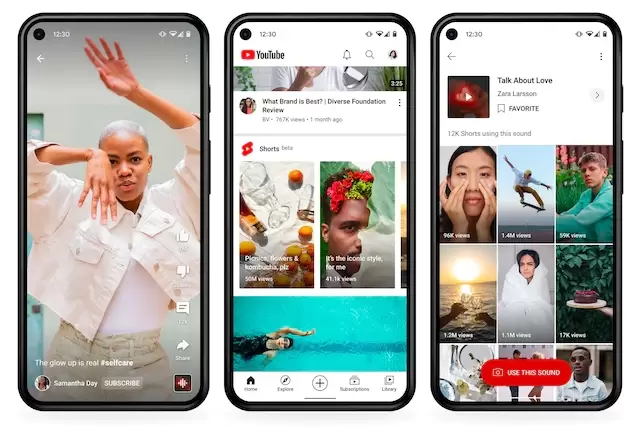YouTube Shorts could Steal TikTok’s Thunder with a Better Deal for Creators
 In 2007, only three years after YouTube was founded, the platform unveiled its Partner Program, offering creators 55% of the revenue earned from advertisements served before or during their videos. If the rumors are true, YouTube Shorts creators would get 45% of ad revenue - a smaller cut than they do on YouTube videos, but a substantial upgrade compared to a paltry Creator Fund payout. The secret is that you can’t get rich on TikTok, because even the most viral creators earn a negligible portion of their income from the platform itself. You can’t get rich on TikTok? You can’t embed an ad in the middle of a video - imagine watching a 30-second video with an eight-second ad in the middle - but if you place ads between two videos, who would get the revenue share? A big reason why TikTok and other short-form video apps haven’t unveiled a similar revenue-sharing program yet is because it’s trickier to figure out how to fairly split ad revenue on an algorithmically-generated feed of short videos. The father of these TikTok stars, Marc D’Amelio is the CEO of the family’s ventures, like D’Amelio Brands. Rather, she and her sister Dixie D’Amelio got rich through massive brand deals, a reality show and venture capital investments.
In 2007, only three years after YouTube was founded, the platform unveiled its Partner Program, offering creators 55% of the revenue earned from advertisements served before or during their videos. If the rumors are true, YouTube Shorts creators would get 45% of ad revenue - a smaller cut than they do on YouTube videos, but a substantial upgrade compared to a paltry Creator Fund payout. The secret is that you can’t get rich on TikTok, because even the most viral creators earn a negligible portion of their income from the platform itself. You can’t get rich on TikTok? You can’t embed an ad in the middle of a video - imagine watching a 30-second video with an eight-second ad in the middle - but if you place ads between two videos, who would get the revenue share? A big reason why TikTok and other short-form video apps haven’t unveiled a similar revenue-sharing program yet is because it’s trickier to figure out how to fairly split ad revenue on an algorithmically-generated feed of short videos. The father of these TikTok stars, Marc D’Amelio is the CEO of the family’s ventures, like D’Amelio Brands. Rather, she and her sister Dixie D’Amelio got rich through massive brand deals, a reality show and venture capital investments.
Charli and Dixie D’Amelio may not make their millions from the TikTok app itself, but they wouldn’t have gotten the opportunity to work on their very own fashion line and reality show if not for their TikTok stardom. Instagram even had to walk back some TikTok-like changes to its app after users (including Kylie Jenner and Kim Kardashian) expressed such deep distaste for them. But users still don’t seem to want a TikTok-like experience from Instagram. “I will say I don’t rely on it anymore,” Tyler Gaca (ghosthoney) told TechCrunch in June. “The Creator Fund doesn’t really help as much anymore,” he said. But as Creator Fund payouts became less reliable, Gaca turned to podcasting and other writing projects for more sustainable income. Longtime internet creator Hank Green said in a video about the Creator Fund that he initially made about five cents per thousand views, but the number of creators in the program outpaced the growth of the program itself. That’s because TikTok’s Creator Fund model simply doesn’t work. That’s less than 10% of the time TikTok users spend on the platform, a cumulative 197.8 million hours a day. Even the YouTuber MrBeast (Jimmy Donaldson), who out-earned every other creator by making $54 million last year, can’t seem to make good money on TikTok.
But, according to reports from The New York Times, YouTube Shorts is gearing up to announce an ad revenue-sharing model that could revolutionize short-form video and give TikTok a run for its money - literally. As Louderback said, creators will follow the money. If it can pull off this ad revenue share model, YouTube Shorts now has a chance to prove itself as the best way for short-form video creators to make a living. Update, 9/20/22, 1:30 PM ET: YouTube confirmed ad revenue sharing for Shorts. The company is reportedly set to announce a Partner Program-like ad revenue sharing model on Tuesday at its Made on YouTube event. That might sound like a lot of money, but by comparison, YouTube paid creators over $30 billion in ad revenue over the last three years. With these challenges, running a creator business can feel unsustainable - but with the amount of value creators generate for these platforms, it shouldn’t be that way. Of course, TikTok can be life-changing for creators who build an audience on the platform. When creators build their audience on TikTok, the platform doesn’t remain their bread and butter for long.
Da ta w as c reated with GSA Co ntent Generator DE MO .
YouTube was arguably the first platform that made it possible for creative people to earn a living by posting interesting content on the internet. What about Charli D’Amelio, who started posting dance videos out of her bedroom in high school and then made $17.5 million in 2021? At that rate, a highly impressive 10 million views per month would net you just $200, which isn’t exactly going to pay the rent. But TikTok pays creators through its Creator Fund, a pool of $200 million unveiled in summer 2020. At the time, TikTok said it planned to expand that pool to $1 billion in the U.S. “Sometimes you post a video and it gets a million views, and sometimes you post a video and it gets 100 views,” Conte told TechCrunch. Or, would a creator whose video you watched earlier in the feed deserve a cut too, because their content encouraged you to keep scrolling? TikTok remains hugely dominant over the copycat short-form video feeds that competing social media giants have spun up in recent years, like Instagram Reels and Snapchat Spotlight. Content w as creat ed by GSA Content Generat or DE MO!

Post a Comment for "YouTube Shorts could Steal TikTok’s Thunder with a Better Deal for Creators"